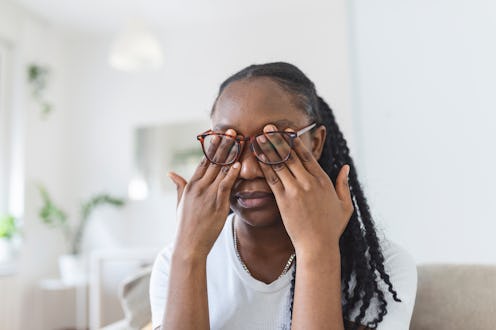Wellness
How To Do "Eye Yoga" For Less Stressed Eyes
Give your peepers a break.

You may have tried your hand at yoga before, but how about eye yoga? Turns out the latter practice is one of the best things you can do for your peepers, especially if you’re someone who wants to (or has to) stare at screens all day long.
Think about it. A typical morning starts with checking your phone (be honest). Then you go to work and spend eight hours staring at a computer. And then you watch Netflix or scroll social media before bed. Add it all up and optometrist Selina McGee, OD says it’s not uncommon to spend 13 hours or more looking at a screen each day.
While it may not seem like a big deal, studies have shown that your blink rate decreases from 20 blinks a minute down to just seven whenever you focus on a screen. And when you do blink, you rarely blink fully. “This causes eyes to miss out on the much-needed hydration from natural tears, which then leads to eye dryness, burning, irritation, and discomfort,” McGee tells Bustle.
Then there’s the issue of eye strain. “If you have normal vision and don't need glasses for the distance, your eyes need to change focus to see things up close,” says optometrist Dr. Norman Shedlo, OD. By staring at a screen all day, especially one that’s right in front of your face, Norman says your eyes have to work overtime to stay focused, which can lead to muscle fatigue.
Symptoms of eye strain or fatigue include redness, dryness, burning and itching, tearing, blurred vision, and even headaches. If you don’t take regular breaks while using screens, Shedlo says it can also lead to bigger problems down the road like nearsightedness. It’s all the more reason to do “eye yoga” exercises throughout the day to help keep your peepers healthy.
How To Do Eye Yoga Exercises To Prevent Eye Strain
Yoga and meditation teacher Phoebe Greenacre recently shared her go-to eye yoga tips with Lenstore, a UK-based vision care company. And according to eye docs, these moves really do help.
1. Palming
The first eye yoga trick is called palming. To try it, Greenacre says to rub your hands together for 10 seconds before covering both eyes completely with your palms. Look into the darkness and take a few deep breaths. The warmth and darkness will help relax your eye muscles.
2. Rapid Blinking
Next, try a round of rapid blinking, which Shedlo recommends as well. “Studies show that simple activities like blinking more while working on the computer or phone helps reduce fatigue of the eye muscles,” he tells Bustle.
To blink the eye yogi way, Greenacre suggests sitting up straight in your chair and blinking your eyes quickly for 10 to 15 seconds. Repeat the process every hour to ensure your eyes stay nice and moist.
3. Zooming
If you notice eye pain or a headache coming on, take that as your cue to “zoom.” Greenacre recommends sitting back in your chair and allowing your eyes to focus on an object across the room for a few seconds. Next, focus on something slightly closer for a few seconds, then something right in front of you, like your hand. Reverse the process and repeat for two minutes.
Looking at a distant object for a few seconds every 20 to 30 minutes can help reduce symptoms of eye fatigue. The reason? “It relaxes the focusing muscles in the eye and helps reduce eye strain,” Shedlo says.
A similar trick is the 20/20/20. According to Dr. Caleen Burke, an optometrist with Burke Eyecare, you can prevent digital eyestrain by taking a break every 20 minutes to look at something 20 feet away for 20 seconds. Like the “zoom” exercise, it will give your eyes a chance to refocus.
4. Figure Eight
To “stretch” your eye muscles, try moving your eyes in a figure-eight pattern. Greenacre says to raise your hand at eye level, extend your thumb, and focus on it. Slowly start to move your arm in figure-eight shape as your eyes follow along. Keep tracing a figure eight for 30 seconds, then switch directions.
5. Eye Rolling
Eye rolling can also help relax and strengthen your eye muscles, Greenacre says. To give it a try, sit or stand straight, relax your shoulders, and gaze forward. Without moving your head, look to your right, then slowly move your gaze to the ceiling, then look to the left, then down towards the floor. Go in both directions and just like that, you’ll have performed a nice round of eye yoga. Namaste.
Studies referenced:
Al-Mohtaseb, Z., Schachter, S., Shen Lee, B., Garlich, J., & Trattler, W. (2021). The Relationship Between Dry Eye Disease and Digital Screen Use. Clinical ophthalmology (Auckland, N.Z.), 15, 3811–3820. https://doi.org/10.2147/OPTH.S321591.
Coles‐brennan, C., Sulley, A., & Young, G. (2019). Management of digital eye strain. Clinical and Experimental Optometry, 102(1), 18–29. https://doi.org/10.1111/cxo.12798.
Gupta, S. K., & Aparna, S. (2020). Effect of Yoga Ocular Exercises on Eye Fatigue. International journal of yoga, 13(1), 76–79. https://doi.org/10.4103/ijoy.IJOY_26_19.
Kim S. D. (2016). Effects of yogic eye exercises on eye fatigue in undergraduate nursing students. Journal of physical therapy science, 28(6), 1813–1815. https://doi.org/10.1589/jpts.28.1813.
Sheppard, A. L., & Wolffsohn, J. S. (2018). Digital eye strain: prevalence, measurement and amelioration. BMJ open ophthalmology, 3(1), e000146. https://doi.org/10.1136/bmjophth-2018-000146.
Sources:
Selina McGee, OD, optometrist
Dr. Norman Shedlo, OD, optometrist
Phoebe Greenacre, yoga and meditation teacher
Dr. Caleen Burke, optometrist
This article was originally published on